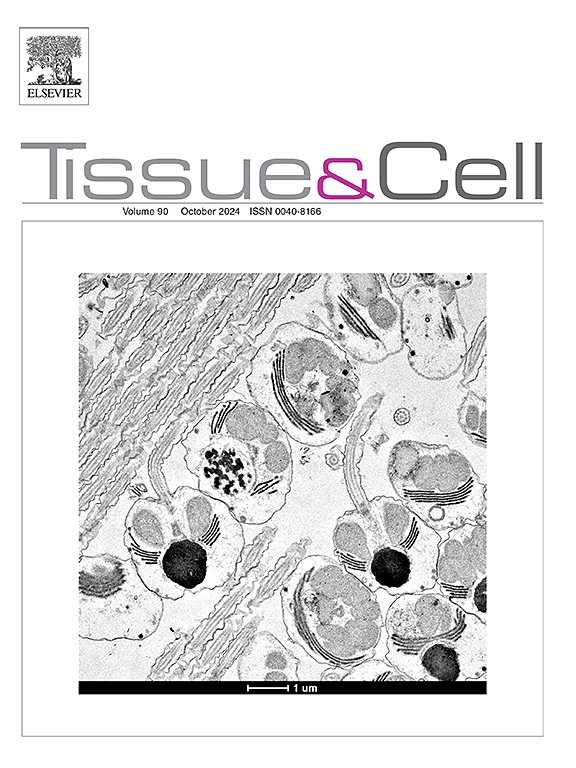Tetracera asiatica flavonoids attenuate alcohol-induced liver injury by suppressing oxidative stress and inflammation mediated by the Keap-1/Nrf2/HO-1, NF-κB/MAPK and PERK/Nrf2 signaling pathways in alcoholic liver injury rats
IF 2.7
4区 生物学
Q1 ANATOMY & MORPHOLOGY
引用次数: 0
Abstract
Alcoholic liver disease is regarded as a leading reason for liver cirrhosis. This study aimed to investigate the protective effect of tetracera asiatica flavonoids (TAF) on alcoholic liver injury (ALI) and explore the associated mechanisms. An ALI rat model was established and then divided into four groups, including ALI group, low-dose TAF (l-TAF) group, medium-dose TAF (m-TAF) group, and high-dose TAF (h-TAF) group. Levels of ALT, AST, ALB, SOD, MDA, NO, CAT, TG, TNF-α, IL-1β, Nrf2, Keap1, HO-1, NQO-1, and GSH-Px were measured in ALI rats in different groups. Pathological changes and inflammatory infiltration were examined using HE staining. Western blot was used to detect expressions of Nrf2, MAPK p38, PERK, NF-κB, ERK1/2 and anti-JNK1/2/3. The results showed that TAF protected against alcoholic liver injury in ALI rats by decreasing ALT and AST levels and inhibiting inflammatory response. TAF significantly reversed alcohol-induced increase in NO (P < 0.05), and remarkably decreased levels of TNF-α (P < 0.001) and IL-1β (P < 0.01), compared with the ALI group. TAF significantly increased the transcription of Nrf2, Keap1, HO-1, NQO-1 and GSH-Px gene (all P < 0.05) and inhibited the alcohol-induced upregulation of MAPK p38 expression (P < 0.001), p-NF-κB/NF-κB ratio (P < 0.001), p-ERK/1/2/ERK1/2 ratio (P < 0.05), and p-JNK1/2/3/JNK1/2/2 ratio (P < 0.05), compared with the ALI group (all P < 0.001). TAF obviously reversed effects of ALI modeling, and remarkably downregulated the expression of PERK and upregulated Nrf2 (all P < 0.001) compared with the ALI rats. In conclusion, TAF attenuates alcohol-induced livery injury through suppressing Keap-1/Nrf2/HO-1, NF-κB/MAPK and PERK/Nrf2 signaling pathways mediated oxidative stress and inflammation in ALI rats.
黄酮类化合物通过抑制酒精性肝损伤大鼠Keap-1/Nrf2/HO-1、NF-κB/MAPK和PERK/Nrf2信号通路介导的氧化应激和炎症,减轻酒精性肝损伤
酒精性肝病被认为是肝硬化的主要原因。本研究旨在研究亚洲四叶草总黄酮(TAF)对酒精性肝损伤(ALI)的保护作用,并探讨其机制。建立ALI大鼠模型,将其分为ALI组、低剂量TAF (l-TAF)组、中剂量TAF (m-TAF)组、高剂量TAF (h-TAF)组。测定各组ALI大鼠的ALT、AST、ALB、SOD、MDA、NO、CAT、TG、TNF-α、IL-1β、Nrf2、Keap1、HO-1、NQO-1、GSH-Px水平。HE染色检查病理改变及炎症浸润。Western blot检测Nrf2、MAPK p38、PERK、NF-κB、ERK1/2、anti-JNK1/2/3的表达。结果表明,TAF通过降低ALT和AST水平,抑制炎症反应,对ALI大鼠酒精性肝损伤具有保护作用。与ALI组相比,TAF显著逆转了酒精诱导的NO升高(P <; 0.05),显著降低了TNF-α (P <; 0.001)和IL-1β (P <; 0.01)的水平。TAF的转录显著提高Nrf2、Keap1 HO-1, NQO-1和氧化酶基因(所有P & lt; 0.05)和抑制MAPK的饮酒导致的upregulation p38表达(P & lt; 0.001),p-NF -κB / NF -κB比率(P & lt; 0.001),p-ERK 1/2 / ERK1/2比率(P & lt; 0.05),和p-JNK1/2/3 / JNK1/2/2比率(P & lt; 0.05),相比之下,阿里集团(所有P & lt; 0.001)。与ALI大鼠相比,TAF明显逆转ALI模型的作用,显著下调PERK表达,上调Nrf2表达(P均为 <; 0.001)。综上所述,TAF通过抑制Keap-1/Nrf2/HO-1、NF-κB/MAPK和PERK/Nrf2信号通路介导的ALI大鼠氧化应激和炎症,减轻了酒精诱导的肝损伤。
本文章由计算机程序翻译,如有差异,请以英文原文为准。
求助全文
约1分钟内获得全文
求助全文
来源期刊

Tissue & cell
医学-解剖学与形态学
CiteScore
3.90
自引率
0.00%
发文量
234
期刊介绍:
Tissue and Cell is devoted to original research on the organization of cells, subcellular and extracellular components at all levels, including the grouping and interrelations of cells in tissues and organs. The journal encourages submission of ultrastructural studies that provide novel insights into structure, function and physiology of cells and tissues, in health and disease. Bioengineering and stem cells studies focused on the description of morphological and/or histological data are also welcomed.
Studies investigating the effect of compounds and/or substances on structure of cells and tissues are generally outside the scope of this journal. For consideration, studies should contain a clear rationale on the use of (a) given substance(s), have a compelling morphological and structural focus and present novel incremental findings from previous literature.
 求助内容:
求助内容: 应助结果提醒方式:
应助结果提醒方式:


